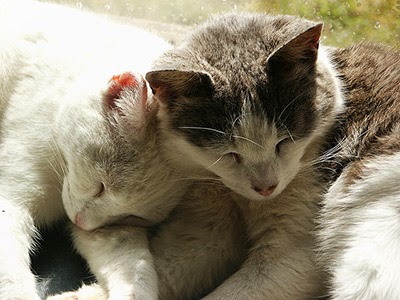Cats
Following our recent survey which revealed that many cat owners do not recognise the signs of stress, we hosted a live Q&A session on our Facebook page focusing on cats and stress. Our supporters asked questions which were answered by Nicky Trevorrow, Cats Protection’s Behaviour Manager.
If you notice any change in your cat’s behaviour, the first step is to get it checked out by a vet to ensure there are no underlying medical causes. Your vet will have access to your cat’s history and will be able to carry out an examination.
If your cat is given a clean bill of health by the vet you can investigate a behavioural cause by enlisting the help of a qualified behaviourist (find one at www.apbc.org.uk).
Here are some of the questions that came up in the Q&A:
Question: How can I help my two-year-old female cat with the stress/fright she is experiencing with a brand new cat we have taken on in the house? How long should I allow for the two cats to integrate?
Answer: This is an extremely common problem and sadly there's no magic length of time for how long the integration period takes. It needs to be done at the speed of the cat that is coping the least well – if in any doubt, really slowly! Start with the scent swapping stage. This is the one that most people either don't know about or progress through too quickly. While the cats are still kept separately, get a couple of clean cloths and rub one cloth on one of the cat's scent glands (cheeks, forehead and sides of body) and then put this in the middle of the floor for the other cat to investigate in their own time. Do the same for the other cat. The signs are very subtle. If the cat sniffs the cloth and ignores it – this is a good sign, if the cat avoids walking anywhere near the cloth – this is a bad sign. Create positive associations with the cloths by playing with the cat near them and offering them small treats. For more information on the rest of the stages, see our Essential Guide leaflet Cats living together.
Question: We are moving house soon. How do we make it less stressful for our two cats?
Answer: Firstly change the microchip details as soon as you move house. Plug in a Feliway® diffuser in a room in the new house a week before the move if possible. Set this room up with all the cats' things to make it a sanctuary room so they feel safe and give them plenty of places to hide. Cardboard boxes are fantastic – always cut two holes in the sides of the box to provide an entry and exit point. Depending on how they cope and their personalities, gradually get them used to the rest of the house, one room at a time. Check out our leaflets – Welcome home and Moving house for more information.
Question: Our Burmese boy is very vocal and overgrooms at times too. What can we do to help?
Answer: While overgrooming can be a sign of stress, it's really important to take your cat to the vets to rule out medical reasons. If you can observe whether he seems to chew/pluck/nibble at the fur and whether he breaks the skin and let the vet know all your observations, this can help with diagnosis. If your vet feels it's behavioural, then to identify the underlying behavioural cause, we recommend that you find a qualified behaviourist near you, check out www.apbc.org.uk
Question: My cat has suddenly started peeing on my bed. Could this be due to stress? She doesn't have an infection and has never peed outside her tray until recently.
Answer: Sorry to hear that your cat is peeing outside of the tray. When you say that she doesn't have an infection, has the vet tested a urine sample? If not, that's the first port of call. It's important to differentiate between inappropriate urination (a puddle on the floor) versus spraying (backing up to a vertical surface and spraying a small amount of urine). Each has different motivations. Cats sometimes spray short bursts of urine on vertical objects outside to mark territory and leave information for themselves or other cats to ‘read’. If your cat starts to spray inside the home, then it is almost certainly a sign that all is not right in their world. Once you've checked your cat's health at the vets, make sure you put litter trays in quite, private locations and clean them twice a day. Use large trays (covered as well as open ones for choice), 3cm of soft sand-sized (non-scented) litter, and don not use odorisers or litter tray liners. You may find our Essential Guide leaflet Managing your cat’s behaviour helpful to read.
Question: I had a baby seven weeks ago. I think my cats are upset with me and feel like I don't have time for them. Is there anything I can do to comfort them?
Answer: Sorry to hear that you're experiencing problems with your cat at the moment. It's a common concern from new mothers; however I'd like to reassure you that your cats aren’t upset with you, but unsettled by the change in routine and the new smells and sounds of the baby. Naturally it's hard to provide as much fuss as previously, but even if you could schedule in consistent small play and fuss sessions with your cat and have a new regular routine, this can help them adjust. In addition, Feliway® can help to promote a feeling of familiarity in the home environment – ask your vet for more details. For more info check out our leaflet Cats and people.
Thank you to all of our Facebook supporters who took part in the Q&A with Nicky.
Please remember that if there is any change in your cat’s behaviour, you should take it to a vet for an examination.
You’ll find more information about cat care and behaviour in our Essential Guide leaflets and do check out our free online e-learning course to understand feline origins.
- Behaviour Focus: Litter Trays
In this week’s behaviour focus post, Cats Protection Behaviour Manager Nicky Trevorrow discusses why cats may not use their litter tray. Why does my cat poo/wee on the furnishings in my house rather than in their litter tray? It’s clean! This is the...
- ‘how Do I Teach My Cat To Use The Cat Flap?’ And Other Behaviour Faqs
Last week feline behaviour specialist Nicky Trevorrow returned to our national Facebook page to answer questions on cat behaviour. Here are some of the queries she answered: Question: How do I get my Billy to come in through the cat flap? We've had...
- ‘how Can I Help A Timid Cat Trust Their New Owner?’ And Other Behaviour Faqs
Once more behaviour expert Nicky Trevorrow took the reins of our Facebook page and answered live feline behaviour questions from our supporters. Here are just some of the questions that she answered for our supporters: Question: Please could you offer...
- ‘why Is My Cat Aggressive?’ And Other Cat Behaviour Faqs
In our most recent live Facebook Q&A session, Cats Protection Behaviour Manager Nicky Trevorrow answered a range of questions about cat behaviour. It’s important that if you notice any change in your cat’s behaviour, you get them checked by a...
- ‘why Does My Cat Meow?’ And Other Cat Behaviour Faqs
Last year we hosted an online Q&A session with Cats Protection’s Behaviour Manager Nicky Trevorrow. It was so popular that we decided to bring them back! Earlier this week we hosted a live Q&A session on our Facebook page with Nicky answering...
Cats
‘Why is my cat spraying?’ and other cat behaviour FAQs
Following our recent survey which revealed that many cat owners do not recognise the signs of stress, we hosted a live Q&A session on our Facebook page focusing on cats and stress. Our supporters asked questions which were answered by Nicky Trevorrow, Cats Protection’s Behaviour Manager.
If you notice any change in your cat’s behaviour, the first step is to get it checked out by a vet to ensure there are no underlying medical causes. Your vet will have access to your cat’s history and will be able to carry out an examination.
If your cat is given a clean bill of health by the vet you can investigate a behavioural cause by enlisting the help of a qualified behaviourist (find one at www.apbc.org.uk).
Here are some of the questions that came up in the Q&A:
Question: How can I help my two-year-old female cat with the stress/fright she is experiencing with a brand new cat we have taken on in the house? How long should I allow for the two cats to integrate?
Answer: This is an extremely common problem and sadly there's no magic length of time for how long the integration period takes. It needs to be done at the speed of the cat that is coping the least well – if in any doubt, really slowly! Start with the scent swapping stage. This is the one that most people either don't know about or progress through too quickly. While the cats are still kept separately, get a couple of clean cloths and rub one cloth on one of the cat's scent glands (cheeks, forehead and sides of body) and then put this in the middle of the floor for the other cat to investigate in their own time. Do the same for the other cat. The signs are very subtle. If the cat sniffs the cloth and ignores it – this is a good sign, if the cat avoids walking anywhere near the cloth – this is a bad sign. Create positive associations with the cloths by playing with the cat near them and offering them small treats. For more information on the rest of the stages, see our Essential Guide leaflet Cats living together.
 |
| Photo courtesy of 48625620@N00 vis flickr |
Answer: Firstly change the microchip details as soon as you move house. Plug in a Feliway® diffuser in a room in the new house a week before the move if possible. Set this room up with all the cats' things to make it a sanctuary room so they feel safe and give them plenty of places to hide. Cardboard boxes are fantastic – always cut two holes in the sides of the box to provide an entry and exit point. Depending on how they cope and their personalities, gradually get them used to the rest of the house, one room at a time. Check out our leaflets – Welcome home and Moving house for more information.
Question: Our Burmese boy is very vocal and overgrooms at times too. What can we do to help?
Answer: While overgrooming can be a sign of stress, it's really important to take your cat to the vets to rule out medical reasons. If you can observe whether he seems to chew/pluck/nibble at the fur and whether he breaks the skin and let the vet know all your observations, this can help with diagnosis. If your vet feels it's behavioural, then to identify the underlying behavioural cause, we recommend that you find a qualified behaviourist near you, check out www.apbc.org.uk
 |
| Photo courtesy of Ollie Harridge via flickr |
Answer: Sorry to hear that your cat is peeing outside of the tray. When you say that she doesn't have an infection, has the vet tested a urine sample? If not, that's the first port of call. It's important to differentiate between inappropriate urination (a puddle on the floor) versus spraying (backing up to a vertical surface and spraying a small amount of urine). Each has different motivations. Cats sometimes spray short bursts of urine on vertical objects outside to mark territory and leave information for themselves or other cats to ‘read’. If your cat starts to spray inside the home, then it is almost certainly a sign that all is not right in their world. Once you've checked your cat's health at the vets, make sure you put litter trays in quite, private locations and clean them twice a day. Use large trays (covered as well as open ones for choice), 3cm of soft sand-sized (non-scented) litter, and don not use odorisers or litter tray liners. You may find our Essential Guide leaflet Managing your cat’s behaviour helpful to read.
Question: I had a baby seven weeks ago. I think my cats are upset with me and feel like I don't have time for them. Is there anything I can do to comfort them?
Answer: Sorry to hear that you're experiencing problems with your cat at the moment. It's a common concern from new mothers; however I'd like to reassure you that your cats aren’t upset with you, but unsettled by the change in routine and the new smells and sounds of the baby. Naturally it's hard to provide as much fuss as previously, but even if you could schedule in consistent small play and fuss sessions with your cat and have a new regular routine, this can help them adjust. In addition, Feliway® can help to promote a feeling of familiarity in the home environment – ask your vet for more details. For more info check out our leaflet Cats and people.
 |
| Photo courtesy of CP Library |
Thank you to all of our Facebook supporters who took part in the Q&A with Nicky.
Please remember that if there is any change in your cat’s behaviour, you should take it to a vet for an examination.
You’ll find more information about cat care and behaviour in our Essential Guide leaflets and do check out our free online e-learning course to understand feline origins.
- Behaviour Focus: Litter Trays
In this week’s behaviour focus post, Cats Protection Behaviour Manager Nicky Trevorrow discusses why cats may not use their litter tray. Why does my cat poo/wee on the furnishings in my house rather than in their litter tray? It’s clean! This is the...
- ‘how Do I Teach My Cat To Use The Cat Flap?’ And Other Behaviour Faqs
Last week feline behaviour specialist Nicky Trevorrow returned to our national Facebook page to answer questions on cat behaviour. Here are some of the queries she answered: Question: How do I get my Billy to come in through the cat flap? We've had...
- ‘how Can I Help A Timid Cat Trust Their New Owner?’ And Other Behaviour Faqs
Once more behaviour expert Nicky Trevorrow took the reins of our Facebook page and answered live feline behaviour questions from our supporters. Here are just some of the questions that she answered for our supporters: Question: Please could you offer...
- ‘why Is My Cat Aggressive?’ And Other Cat Behaviour Faqs
In our most recent live Facebook Q&A session, Cats Protection Behaviour Manager Nicky Trevorrow answered a range of questions about cat behaviour. It’s important that if you notice any change in your cat’s behaviour, you get them checked by a...
- ‘why Does My Cat Meow?’ And Other Cat Behaviour Faqs
Last year we hosted an online Q&A session with Cats Protection’s Behaviour Manager Nicky Trevorrow. It was so popular that we decided to bring them back! Earlier this week we hosted a live Q&A session on our Facebook page with Nicky answering...
